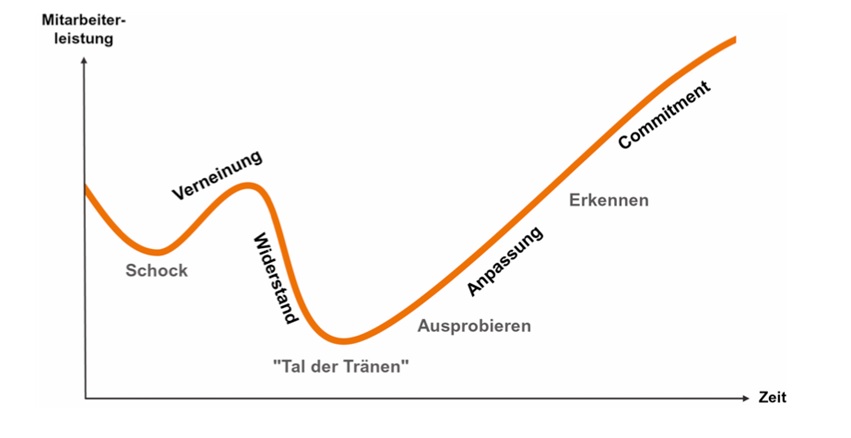Farewell as a leadership task
Expand the table of contents
Exit and termination interviews – clear, empathetic communication
Negotiating the severance package – creating a fair offer
Understanding and supporting the grieving process
Integrating the chance curve in the team and with the departing employee
Staying in touch – the key to a possible return
Summary: Farewell as a leadership task
How can you make the layoff process respectful and forward-looking?
We read, hear and see it in the media almost every day: the German economy is doing badly! The knee-jerk reaction is often to decide that the workforce has to be reduced. There are various approaches to this, such as voluntary redundancy programmes, transitional retirement models and, of course, the ‘good old’ redundancy. In many companies, negotiations are certainly currently taking place with the employee representatives regarding such measures. And difficult talks are also on the cards for suppliers.
Regardless of this, a dismissal is a drastic experience for each individual person, which has an enormous impact on the life and self-image of those affected. For managers, this means taking on one of their most difficult tasks: they have to decide who should leave the team, issue the dismissal (usually together with HR) and manage the impact on the team.
This article offers a detailed guide for managers on how to handle dismissals professionally, fairly and empathetically – because the last impression remains! Practical examples and specific dos and don’ts are provided to support managers.
Read how to manage this difficult process in such a way that a positive relationship is maintained despite the separation. The goal should always be to ensure that dismissed specialists can return at a later date, because every economic crisis is followed by an upturn. Companies that handle the departure respectfully have a chance of winning back the urgently needed skilled workers.
This process affects not only the departing employee, but also the remaining team. It is often the colleagues who stay behind who later report on their positive or negative experience.
Step 1: Selecting the employees to be laid off – transparency and fairness
Once management has decided on the amount to be saved, HR provides information on how many jobs are to be cut in which areas. The responsibility for selecting the affected employees usually lies with the manager. Instead of locking themselves in their office and keeping the team in the dark for a long time, managers should be open about this challenge and explain how they themselves are dealing with this difficult situation.
Managers should schedule an initial team meeting as early as possible to explain what the next steps will be and what transparent, objective criteria will guide the selection. Alternative options such as voluntary redundancy programmes and retirement transition models should also be addressed transparently. This openness helps to prevent speculation and mistrust and strengthens trust in the management.
At this stage, the team is often in shock. Even if it was clear that the business was declining, the certainty that consequences will now follow is difficult to process. The team is confronted with changes that they did not choose themselves.
Step 2: Exit and termination interviews – clear, empathetic communication
Once the selection has been made and agreed with HR, the actual departure process begins with the termination interview.
- Make sure that the employees concerned do not have any important appointments after the interview and, if possible, give them the freedom to go home.
- The conversation should take place in a protected, undisturbed setting, and the message should be conveyed respectfully and clearly. Don’t beat around the bush to buy yourself time. Please don’t make small talk or discuss other topics.
Examples of dialogue for a termination conversation:
Introduction and transparency
‘Mr Meier, I know this is a very difficult conversation. The decision was not an easy one for us to make, and I would like to explain the reasons for it transparently. We are currently facing economic challenges and unfortunately have to cut jobs. Your work has always been valuable, and this decision in no way reflects on your performance.’
Space for emotions
‘I understand that this is shocking news. Please take as much time as you need and feel free to approach me if you have any questions.’
Offer prospects for the future
‘We want to make the transition easier for you and are available to provide a reference. If the situation improves, we would be very happy to have you back on board in the future.’
Step 3: Negotiating the severance package – creating a fair offer
Severance packages should not just meet the minimum legal requirements. A fair severance package shows appreciation and demonstrates that the company is not losing sight of the individual.
Important: Avoid putting additional pressure on the employee during the negotiations and offer to provide support. The goal is for the employee to feel that they have been treated fairly and to refrain from filing an unfair dismissal suit. Here it is important to avoid escalations that often lead to a ‘us against them’ feeling.
Step 4: Understanding and supporting the grieving process
Dismissals are painful incisions that can be perceived as a ‘little death’. The phases of grief – shock, denial, anger, bargaining, depression and acceptance – must be recognised and supported.
For the employee leaving: Allow space for grief and anger. Avoid platitudes such as ‘Life goes on’. An appreciative farewell, for example in the form of an informal meeting or a small farewell party, offers the opportunity to leave positive impressions.
For the remaining team: The colleagues staying behind also go through a grieving process. Be available to answer questions and give the team the chance to talk about the situation together.
Step 5: Integrating the change curve in the team and with the departing employee
The change curve, which describes the emotional progression from shock to acceptance, can provide orientation:
For the departing employee: After the initial shock, coaching for professional reorientation can be helpful. The offboarding process should be concluded with a gesture of appreciation.
For the team: A moderated team retrospective creates space for reflection and helps to develop future prospects together.
Change curve: emotional experience in the change process
As a manager, it is necessary to understand where your employees are on the change curve. Are they still in the mourning phase or are they ready for something new? The answer determines the right time to tackle things. New strategies or structures cannot be implemented if employees are still in a state of shock.
Step 6: Staying in touch – the key to a possible return
Staying in touch with employees who have left can be valuable in the long term. Some may become customers or ambassadors at a later date. An appreciative attitude is also crucial here:
- Invitations to company events: This way, former employees remain part of the network.
- Social networking: Use platforms such as LinkedIn, Xing or Instagram.
- Personal greetings: Small gestures such as birthday greetings keep the bond alive.
Summary: Saying goodbye as a management task
Derived from these six steps, there are some dos and some don’ts for managers when it comes to saying goodbye or giving notice.
The dos include:
- Communicating transparently and creating space for questions.
- Allowing emotions and actively addressing uncertainties.
- Involving the team and honouring the farewell.
- Maintaining contact and thus opening up opportunities for a return.
Managers should avoid the following don’ts:
- Giving notice without warning.
- Sending notice impersonally by email.
- Leaving the team without explanation.
- Breaking off contact with employees leaving the company.
Conclusion: an appreciative farewell process strengthens the corporate culture and lays the foundation for the possible return of valuable employees. Managers who act with empathy and foresight shape the farewell as a long-term investment in the future.
Would you like to find out more about the topic of value-adding and appreciative offboarding? Then we recommend the book Arbeitszeugnisse erstellen in agilen Organisationen by Natalia Hoffmann-Demsing.
If you like the post or want to discuss it, please feel free to share it in your network.
Natalia Hoffmann-Demsing has published two more posts on the t2informatik Blog:

Natalia Hoffmann-Demsing
Natalia Hoffmann-Demsing is an HR mentor, independent business coach and loves people. Her mission is to increase employee satisfaction in companies and reduce staff turnover. She takes a structured, step-by-step approach. She delves deep, identifies pain points and supports companies in finding their own unique path to an enthusiastic workforce.
She has been working for many years with companies in a wide range of industries, including manufacturing, telecommunications and finance. She is a trained systemic business coach, licensed MBTI trainer, trainer (IHK), Agile Coach and author of specialist books (Haufe and ManagerSeminare).
She sees herself as a link between the traditional and agile worlds of work and moves playfully between the two. People are always at the centre of her work, as is the creation of parameters in which people can effectively contribute their strengths and work with intrinsic motivation.
In the t2informatik Blog, we publish articles for people in organisations. For these people, we develop and modernise software. Pragmatic. ✔️ Personal. ✔️ Professional. ✔️ Click here to find out more.



